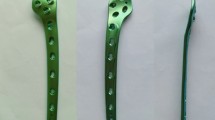Summary.
In an experimental study, the biomechanical qualities of the combined Kirschner wire osteosynthesis (KWO) in the unstable Colles' fracture were analyzed. This type of pin fixation is our preferred osteosynthesis in the treatment of unstable Colles' fracture because it allows immediate functional therapy. It represents a modification of Kapandji's dynamic KWO, compensating for the insufficient volar stability by means of the conventional static KWO. Clinical experience according to the anatomical and functional results, was very encouraging suggesting that a clinical concept based on the biomechanical principles of combined KWO and its single components should be constituted. Simulation of the unstable Colles' fracture was realized by dorsal wedge osteotomy of the distal end of the radius using cadaveric material. This fracture model was subsequently pinned using the different KWO types and tested by a standardized vector energy testing device regarding its stability in the four main loading directions. The combined KWO unifies the advantage of volar stability of the conventional KWO with the high dorsal stability of dynamic KWO. The main functional principle of dynamic KWO with regard to its axial stability consists in the repositioning of the dorsal bone fragmentation zone and hence the reconstitution of cortical load transmission. Besides its good stabilization, dynamic KWO also leads to optimal alignment of the distal metaphyseal fragment. Furthermore, the experiments yielded important information about technical aspects of the surgical procedure, which helps us to avoid anatomical and functional deficiencies. Based on these experimental findings, the surgical technique of combined KWO was standardized.
Zusammenfassung.
Im Rahmen einer experimentellen Studie werden die biomechanischen Eigenschaften der kombinierten Kirschnerdraht-Osteosynthese (KDO) bei der dorsal instabilen, distalen Radiusfraktur analysiert. Bei dieser Osteosynthese handelt es sich um ein übungsstabiles Verfahren, das in der Chirurgischen Universitätsklinik Heidelberg seit 1989 routinemäßig bei der instabilen Colles-Fraktur des distalen Radius zum Einsatz kommt. Zur Beantwortung von klinischen Fragestellungen mußte eine wissenschaftliche Grundlage für das biomechanische Funktionsprinzip der kombinierten KDO und ihrer einzelnen Komponenten geschaffen werden. Zur Simulation der Colles-Fraktur wurde ein Osteotomiemodell am Leichenunterarm entwickelt. Dieses wurde nacheinander mit den verschiedenen KDO-Typen versorgt und in den 4 Hauptbelastungsrichtungen mit einer Universalprüfmaschine auf ihre Stabilität getestet. Die kombinierte KDO vereinigt die Vorteile der volaren Stabilität der konventionellen KDO mit der hohen dorsalen Stabilität der dynamischen Spickung. Das wesentliche Funktionsprinzip der dynamischen Kirschner-Drähte (KD) bzgl. der axialen Stabilität besteht in der Reposition der Trümmerzone und damit Wiederherstellung der corticalen Kraftübertragung. Die dynamischen KD besitzen neben ihrer stabilisierenden Wirkung auch einen Repositionseffekt. Desweiteren ergaben die Experimente Aufschlußüber operationstechnische Aspekte, die zur Vermeidung von Fehlern bei der klinischen Anwendung führten. Auf der Basis der experimentellen Befunde konnte die klinische Operationstechnik optimiert und standardisiert werden.
Similar content being viewed by others
Author information
Authors and Affiliations
Rights and permissions
About this article
Cite this article
Fritz, T., Heyer, T., Krieglstein, C. et al. Biomechanik der kombinierten Kirschnerdraht-Osteosynthese am humanen Modell der dorsal instabilen, distalen Radiusfraktur (Colles-Typ). Chirurg 68, 496–502 (1997). https://doi.org/10.1007/s001040050219
Issue Date:
DOI: https://doi.org/10.1007/s001040050219




